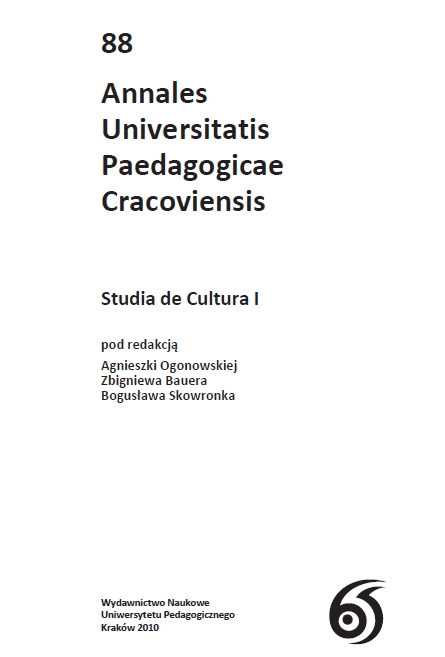Abstrakt
Indigenisation of the content of contemporary mass media message
The nature of the mass media functioning in the contemporary culture provides new research opportunities for a cultural anthropologist: the analysis of the message content indigenisation process. Drawing on the writings of Arjun Appadurai, the author speaks about indigenisation and not “localisation”, so as not to associate this phenomenon with a specific spatial location, but to put the emphasis on the locality as an indispensable element of human life. The author analyses the process of the “production of locality” under the influence of the mass media. The audience gives meaning to global content by “reducing” it to a comprehensible, “familiar” image of the world; thus, this content differs locally. As the result of indigenisation, the audience share not only the same information but also imagination. The activity of the audience, which maintains sustained communication interaction with the mass media and among audience participants, as well as the culture space making it possible to “create meanings” of approved content, determine the necessity to regularly “sustain” the process of the “production” of locality, and thus to ensure durability of a specific audience. Thereby, new phenomena emerge in the culture: the “production” of locality leads to the emergence of virtual neighbourhoods, and the fan type prevails in the reception of the content of contemporary mass media messages.
Bibliografia
Appadurai A. (2005), Nowoczesność bez granic. Kulturowe wymiary globalizacji, przeł. Z. Pucek, Kraków.
Zobacz w Google Scholar
Bachtin M. (1982), Problemy literatury i estetyki, przeł. W. Grajewski, Warszawa.
Zobacz w Google Scholar
Bachtin M. (1986), Estetyka twórczości słownej, przeł. D. Ulicka, Warszawa.
Zobacz w Google Scholar
Bauer Z. (2009), Dziennikarstwo wobec nowych mediów. Historia. Teoria. Praktyka, Kraków.
Zobacz w Google Scholar
Castells M. (2007), Społeczeństwo sieci, przeł. M. Marody, K. Pawluś, J. Stawiński, S. Szymański, Warszawa.
Zobacz w Google Scholar
Dajan D., Katz E. (2008), Wydarzenia medialne. Historia transmitowana na żywo, przeł. A. Sawicz, Warszawa.
Zobacz w Google Scholar
Giddens A. (2007), Nowoczesność i tożsamość. „Ja” i społeczeństwo w epoce późnej nowoczesności, przeł. A. Szulżycka, Warszawa.
Zobacz w Google Scholar
Hall S. (1987), Kodowanie i dekodowanie, „Przekazy i Opinie” nr 1–2.
Zobacz w Google Scholar
Kuligowski W. (2007), Antropologia współczesności. wiele światów, jedno miejsce, Kraków.
Zobacz w Google Scholar
Lull J. (1990), The Social Uses of Television, [w:] tegoż, Inside Family Viewing: Ethnografic Research on Television’s Audiences, London and New York cyt. za Halawa M. (2006), Życie codzienne z telewizorem. Z badań terenowych, Warszawa.
Zobacz w Google Scholar
McQuail D. (2008), Teoria komunikowania masowego, przeł. M. Bucholc, A. Szulżycka, Warszawa.
Zobacz w Google Scholar
Morley D. (2003), Być w domu w mobilnym świecie, przeł. M. Halawa, „Kultura Popularna” nr 3.
Zobacz w Google Scholar
Ogonowska A. (2006), Voyeuryzm telewizyjny. Między ontologią telewizji a rzeczywistością telewidza, Kraków.
Zobacz w Google Scholar
Ricoeur P. (2006), Model tekstu. Znaczące działanie rozważane jako tekst, przeł. B. Baran, [w:] Współczesne teorie socjologiczne, wybór i oprac. A. Jasińska-Kania, L.M. Nijakowski,
Zobacz w Google Scholar
J. Szacki, M. Ziółkowski, t. II, Warszawa.
Zobacz w Google Scholar
Stomma L. (1986), Antropologia kultury wsi polskiej XIX w., Warszawa.
Zobacz w Google Scholar
Sulima R. (2003), Znikająca codzienność, [w:] Życie codzienne Polaków na przełomie XX i XXI wieku, pod red. tegoż, Łomża.
Zobacz w Google Scholar
Sulima R. (2005), Czas na chwilę zatrzymany, z antropologiem kultury rozmawia E. Czaczkowska, „Rzeczpospolita”, dodatek z 5 kwietnia.
Zobacz w Google Scholar
Thompson J.B. (1998), Media i nowoczesność. Społeczna teoria mediów, przeł. I. Mielnik, Wrocław.
Zobacz w Google Scholar
Tokarska-Bakir J. (2000), Obraz osobliwy. Hermeneutyczna lektura źródeł etnograficznych. Wielkie opowieści, Kraków.
Zobacz w Google Scholar
Turner V. (2005), Od rytuału do teatru. Powaga zabawy, przekł. M.J. Dziekanowie, Warszawa.
Zobacz w Google Scholar

Utwór dostępny jest na licencji Creative Commons Uznanie autorstwa – Użycie niekomercyjne 4.0 Międzynarodowe.
Prawa autorskie (c) 2023 Annales Universitatis Paedagogicae Cracoviensis | Studia de Cultura

